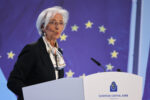FMW-Redaktion
Mario Draghi sprach gestern bei einer Rede in Italien über die EZB-Geldpolitik und die wirtschaftliche Entwicklung in der Eurozone. Nach seiner Meinung wächst die Eurozone derzeit mit 1%.
One characteristic of this crisis was the fall in the potential growth rate in the euro area, which is the pace at which the economy can grow on a stable basis without overheating, and so without generating inflation. It is estimated that this rate is now around 1% in the euro area, compared with around 2% in the United States, where the crisis was in fact accompanied by a decline in the potential growth rate as well.
Die Investitionen in der Eurozone seien immer noch 15% unterhalb des Niveaus vor der Finanzkrise 2008.
In determining potential growth, the role of investment is crucial. It increases at once today’s demand and tomorrow’s supply. In the euro area, however, the recovery has thus far mainly concerned consumption and only to a lesser degree involved investment, which is still 15% lower than its pre-crisis levels. This weakness is, moreover, common to other advanced economies as well. In the euro area, investment is being held back primarily by three factors: weak demand, the debt overhang, which was building up already in the period preceding the crisis, and the private sector’s shaky confidence in the growth prospects of our economies.
Laut Mario Draghi waren die Finanzierungskosten für Unternehmen seitens der Banken so hoch, weil sie bei manchen Kreditnehmern hohe Ausfallrisiken sahen. Daher mussten sie hohe Risikoprämien verlangen – in Folge dessen hätten sie aber für alle Kreditkunden die Zinsen erhöht. Damit spielt Mario Draghi wohl indirekt darauf an, dass das Anleihekaufprogramm der EZB notwendig war, um den Gesamtmarkt derart zu überfluten, so dass sich die Finanzierungskosten absenken und Firmen generell leichter an Geld kommen.
One of the reasons that lending rates to firms were high in the past is that, given the weakness of economic conditions, banks particularly feared the risk of enterprises becoming insolvent, and for this reason raised their risk premia. However, these higher rates also caused the demand for credit from healthy firms to fall, thus worsening the conditions of the economy and justifying, ex post, the higher risk premia. And so a vicious circle was created. By reducing borrowing costs for new loans, our measures, especially the targeted longer-term refinancing operations, have encouraged banks to resume lending. The increased competition in credit markets has in turn compressed rates, driving lending and improving the macroeconomic picture. We have thus succeeded in breaking the vicious circle.
Und ja, Mario Draghi ist überzeugt davon, dass sein QE funktioniert.
In addition to the direct impact of targeted longer-term refinancing operations, analyses conducted by the ECB show that the asset purchase programme has had an indirect effect on credit supply conditions, by also improving the macroeconomic outlook and further reducing risk premia. And these measures have not damaged the banks. Far from it. Although they may sometimes have led to a contraction in interest income, our measures have also led to capital gains in banks’ assets, and higher volumes and quality of credit. Considering all of these effects, the staff of the ECB estimate that the impact of our measures on the profitability of the banking sector has been essentially nil for the euro area as a whole.
Quelle: EZB
Kommentare lesen und schreiben, hier klicken












